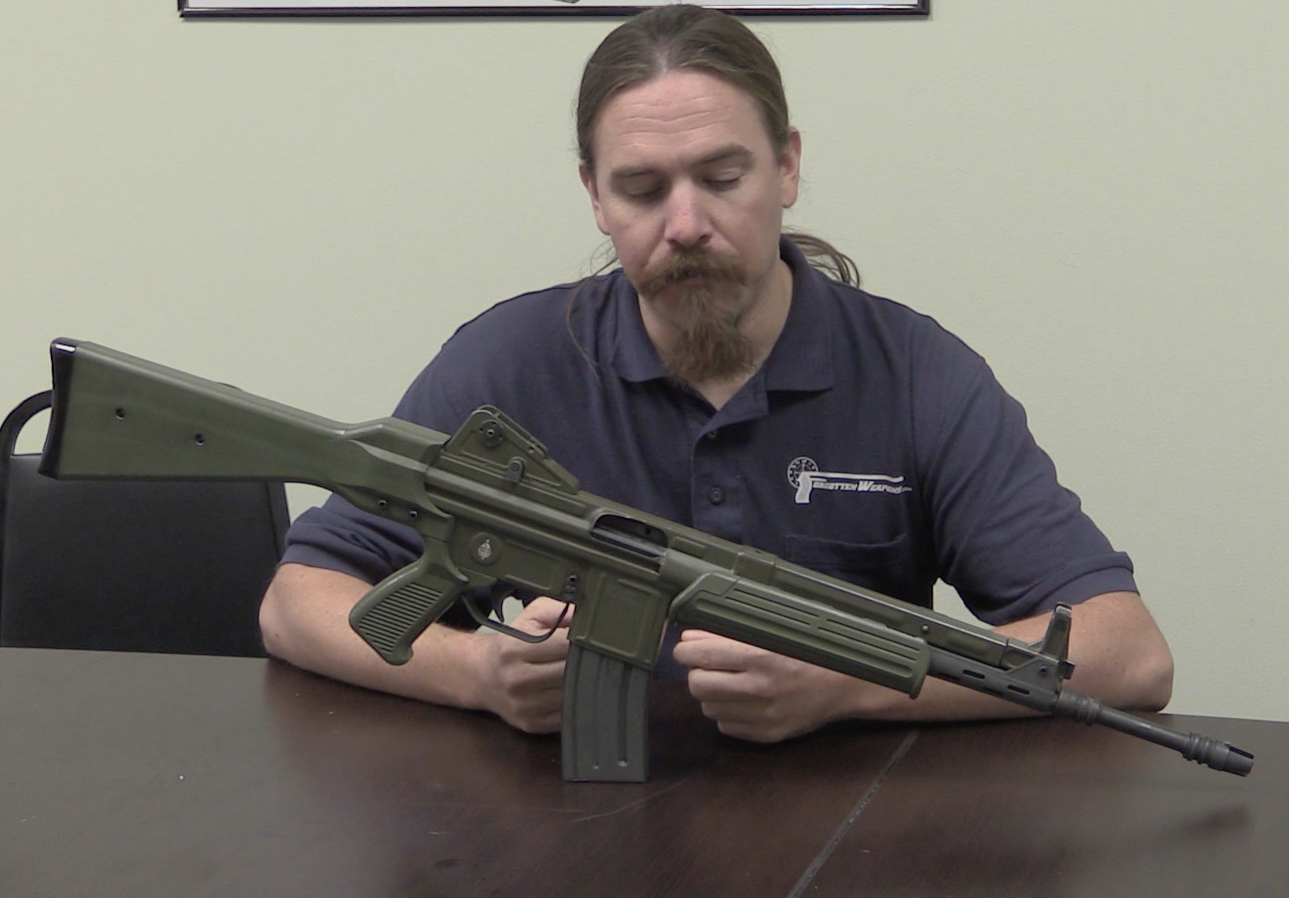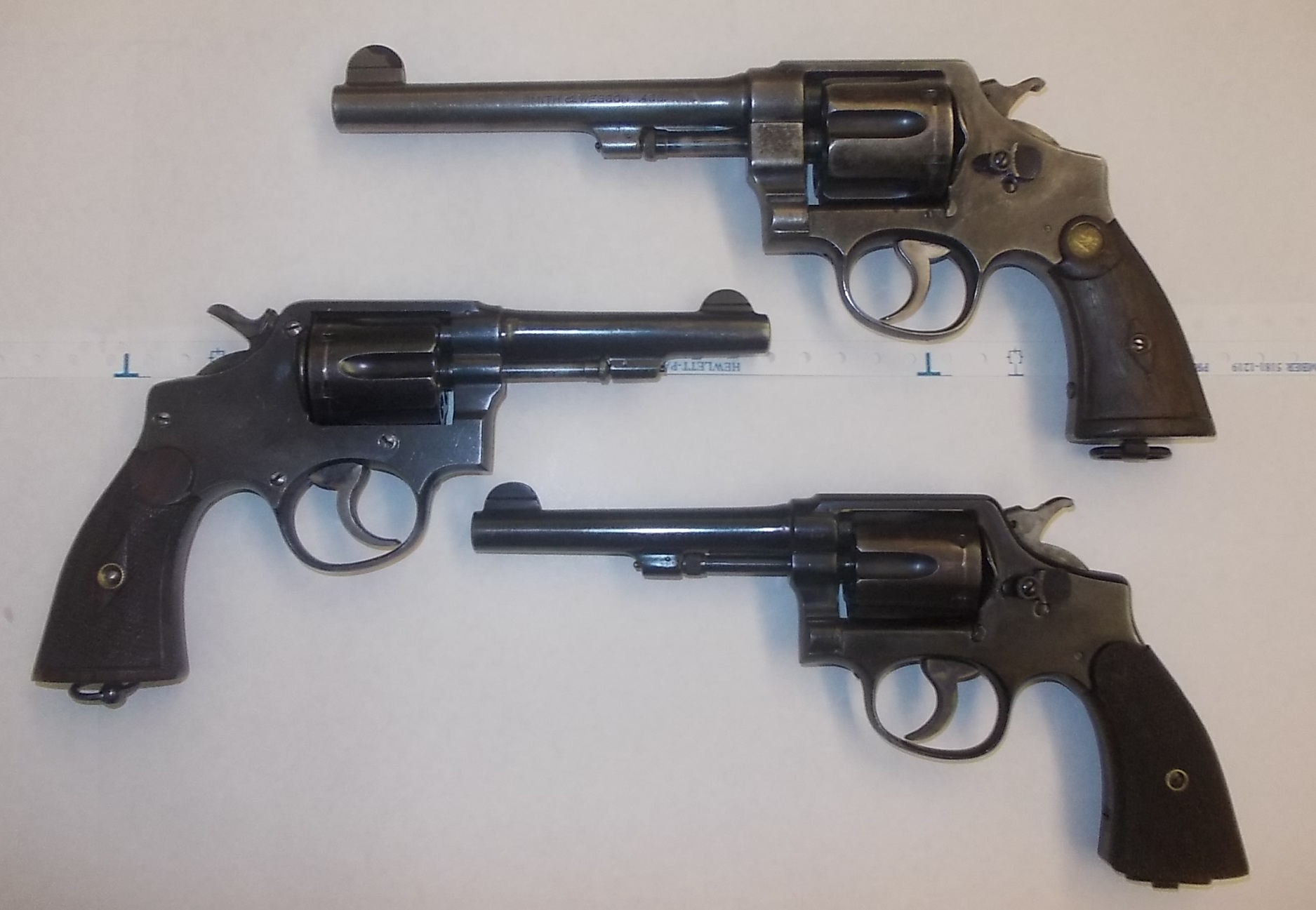The Republican factions in the Spanish Civil War had much more trouble obtaining arms than the Nationalist elements, and this led to several attempts to build pistols in small-scale workshops. The best known of these are the RE and Ascaso copies of the Astra 400, but in the city of Barcelona a group of workers attempted to produce a copy of the 1911/Star pistols in 9mm Largo – except as simple blowback actions instead of Browning-type locked actions.
Named “Isard” after a Spanish antelope, no more than about 250 were built (the highest recorded serial number is 207) and they show substantial variation between examples as one might expect of handmade guns. There were two main variants, with the later guns using a two-piece frame and a distinctive extended barrel and barrel bushing.
Today we have four examples to look at, two early type and two late type. Want to learn more about the Isard in particular, or Spanish pistols in general? I highly recommend these two books:




“copy of the 1911/Star pistols in 9mm Largo – except as simple blowback actions instead of Browning-type locked actions.”
So they wanted to retain external look, but save cost by changing principle of operation to simpler and possibly less comfortable for users (bigger force needed to cycle action).
Anyway it reminded me about Балтиец automatic pistol:
http://oruzhie.info/pistolety/748-baltiets
made in besieged Leningrad, to describe it short: it was Walther PP but rescaled from 7,62×25 Pattern 30 [Tokarev] cartridge, so it is blow-back operated 7,62×25 automatic pistol. Only 14 made (around April 1942).
is: “(…)from(…)”
should be: “(…)for(…)”
The worn grips seem to indicate that someone was very desperate for any gun.
Most of pistol service rounds can be used in blowback handguns with sacrificed shooting comfort and hit efficiency.
This gun seems as been made by really small wokshops. Trigger guards poosibly were made by bent steel strips and welded in their places with swollen weld spots at both end and hand filed, trigger disconnection seems accomplished through camming out by a pin or inside objection of trigger bars at their rearmost travel and the second notch seeming in front of slide stop notch was abandoned in further models since giving no function to retain the slide stop in its place.
“Most of pistol service rounds can be used in blowback handguns with sacrificed shooting comfort and hit efficiency. ”
It should be noted that in Spain there were blow-back automatic pistol firing serious cartridges preceding this one, like for example JO.LO.AR. or Astra 400.
Also, was not 9×23 Largo (with loading used in 1930s) better suited for such type of automatic pistol than Patrone 08? How did maximal allowed pressured (1930s standards) of both compare?
Those are really interesting
OK, last ditch in the Spanish civil war
Anyone who had raised the black flag had been purged, Stalin was willing to lose the proxy war rather than let anyone see any alternative to his own brand of marxist leninism, work.
I wonder whether the purges extended to anyone who had a vague perception of Newtonian mechanics?
Can’t have those inteleck_chew_alls in the marxist leninist paradise…
What was the extended square cornered cut at the back of the ejection port for? Stripper clip loading?
The key to achieving safe blowback is the inertia of the bolt (slide).
And the key to durability of a blowback, is having sufficient spring strength and buffering along with sufficient impact area to prevent the final impact of the moving parts from peening the impact surfaces.
In blowback operation, if you ignore cartridge case friction, the mass of the bullet × the bullet velocity
= bolt mass × bolt velocity
Allowable case movement is usually around 3 mm before the bUlley leaves the barrel
The springs serve to lessen the impact of the bolt on the stop surfaces, they do next to nothing to delay bolt opening,
Bolt opening is controlled by inertia.
Assuming that the pistolsite did have problems with bolts (slides) battering their impact surfaces
The obvious solution would have been to reduce rather than increase the barrel length
And to eliminate the fluted milling cuts at the front of the slide, to increase the weight of the slides.
And to increase the thickness of wire and the preloaded on the recoil spring to increase the retardation of the slide before it reached full travel.
Increasing the number of coils, actually softens a spring and reduces it’s “rate”
To have the recoil spring for a blowback that has roughly the samewire diameter and less free length than the spring for the locked breech version of the same pistol…
Is engineering iliteracy
Sorry for being so harsh
I’d love to see (or own) those pistols
But I wouldn’t want to fire them
“Anyone who had raised the black flag had been purged, Stalin was willing to lose the proxy war rather than let anyone see any alternative to his own brand of marxist leninism, work.”
Query in Russia Wikipedia: https://ru.wikipedia.org/wiki/%D0%93%D1%80%D0%B0%D0%B6%D0%B4%D0%B0%D0%BD%D1%81%D0%BA%D0%B0%D1%8F_%D0%B2%D0%BE%D0%B9%D0%BD%D0%B0_%D0%B2_%D0%98%D1%81%D0%BF%D0%B0%D0%BD%D0%B8%D0%B8#%D0%9F%D0%BE%D0%BB%D0%B8%D1%82%D0%B8%D0%BA%D0%B0_%D0%A1%D0%A1%D0%A1%D0%A0_%D0%B2_%D0%BE%D1%82%D0%BD%D0%BE%D1%88%D0%B5%D0%BD%D0%B8%D0%B8_%D0%98%D1%81%D0%BF%D0%B0%D0%BD%D0%B8%D0%B8
states that Stalin’s standpoint was to not getting involve in Spain, until September 1936. Later, due to Great Britain and France going into compromise (?) with III Reich and fascist Italy, he become to see Spain as potential counterweight.\
Since May 1937 main target of Soviets agents was P.O.U.M. (Partit Obrer d’Unificació Marxista).
I am unable to judge correctness of that view, but it would be logical as P.O.U.M. is described as containing trotskyism.
A decent book on the Spanish Civil War is Antony Beevor’s “The Battle for Spain: The Spanish Civil War 1936-1939”. He does a good job of clarifying a very confusing topic.
Covers the ins and outs of the Republican forces pretty well.
“Is engineering iliteracy ”
Anyway, it proved be good enough to go into some production or in other want times were desperate enough so it would find users.
The Spanish civil war was not a proxy war. It was a fight for Spain by Spaniards. Others became involved after it began.
Actually we don’t know if the wire tickness of the breechlocked and the blowback guns are the same, A tenth of millimeter can make much difference.
For what I can see, the preload of the recoil spring in the 1911, Astra 400 and Isoard can very well be the same, or even with the isoard having a stiffer spring (but a blowback pistol doesn’t need to have a stiffer spring in respect to a short recoil one. The energy absorbed will be the same anyway).
With the preload being the same, the only real disadvantage of a shorter free lenght would be that the 1911 spring will last more / wear more slowly, that’s perfectly acceptable in a last ditch weapon.
The clip on the slide release / disassembly lever pin
Is a clear reference to the tt33
Did any tt33 pistols make it into the Spanish civil war?
I think I’d rather carry a Chinese Mystery Pistol. It would be safer.
The Isoard spring has 28 twists, the 1911 32, the Astra 27. The thickness of the wire is about the same. In all likelyhood they had about the same stiffness when new.
The stiffness of the mainspring has practically no importance in keeping the action of a blowback handgun closed for enough time to safely eject the case. It’s the mass of the slide that does all the work. The only real function of a stiffer mainspring is to mitigate the felt recoil and the force with which the slide slams into the receiver at the end of it’s travel, so a stiffer spring prolongs the life of the frame/slide. However, the force that has to be absorbed is the same for blowback and short recoil pistols. Infact, IE, the Hi-Point mainspring has the same stiffnes of the Glock. More than pointing to the dimension of the spring, Ian should have measured the stiffness of the spring. A smaller spring can have the same stiffness of a bigger one, it wears out quickier, and so has to be replaced more often, but the durability of the spring was probably not the main concern of the designers of this handgun.
“measured the stiffness of the spring”
How do you do that? My understanding is that typically spring has critical force and if it would be extended by that or greater force it would not return to original (resting) shape.
But applying such force would be in category of destructive test, where you are accepting destroying of tested element.
What counts for the present case is simply the force the spring imparts to the slide, in resting position and at the end of the recoil, that requires nothing more complicate than a spring scale.
The “mainspring”? The mainspring is what drives the hammer or striker and fires the gun. I think you are confusing the recoil spring with the mainspring.
Recoil springs mainly, according to their stiffness and burning speed of powder, can not give function at instant of firing especially during the highest pressure existing in the chamber since, through the inertia, their one of the both ends, according the action style, lose the support against to the receiver or slide. They first shrink and then expand as giving resistance against to the recoiling pieces. This is not to keep the bolt in place at the highest pressure occuring within the barrel but to slow the same at its backward travel after an initial case thrown back happened. Inertia of the all the recoiling part masses is the sole effect of blowback / mass lock working principle. Stiffer recoil springs give more slowing effects during the rearward bolt travel, but more harsh slam at end of their returning journey which is also a disadvantage for usable life of the firearm. Good slowing effects can be obtained through one way impact absorbing bumpers like used in VP70, or gas ram pistols like HK P7 in which, so called “Gas Delay” is in fact a “Gas Cushion” solely working a rearward bolt slowing source with no effect at bolt locking at instant of the highest pressure within the barrel occurs.
Yeah. More than a stiffer spring (and, as I already said, when all of them were new the Isoard spring probably had about the same stiffnes of the 1911 and the Astra 400) to prolong the life of the Isoard’s frame/slide (that, given the manufacturing conditions, were not probably made with the best steel in the world) would have been more useful a buffer. Even a washer of a softer metal, like aluminium or copper could do miracles in that respect.
The place where guns were made out of dodgy steel was…
I have no idea what sort of steel the isard was made out of, especially during the chaos of the civil war.
But, please don’t assume that Spanish steels are necessarily of poor quality
Both the Basque country and toledo were renowned for their high quality iron and steel